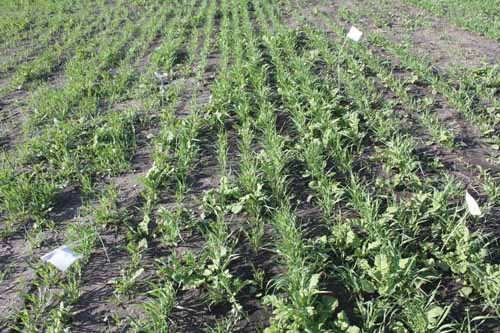Few in Saskatchewan think of a radish as a field scale crop, but one Saltcoats area farmer is using them to help condition his soil.
Kevin Elmy said they have been selling forage radish for the past three years to local customers for use in a cocktail grazing blend, but in researching the crop, he found that this is not their general use.
"When I talked to people in the US that were using them for a long time, I asked what is the best variety to use. They all responded, Tillage Radish," he said. "They are widely grown through the U.S., primarily as a soil conditioner, nutrient cycler, grazing crop, and as a minor use, vegetable crop.
"These are daikon radishes (Japanese for large root). These will be fairly large root, like a carrot, but larger. They have the same taste."
Elmy said they hope to accomplish a few things by growing Tillage Radish.
"In the one field, we seeded 30 pounds of oats and two pounds of Tillage Radish to create a cover crop for seeding Fridge forage winter triticale into," he said. "The oat/tillage radish mix was seeded July 23 into summerfallow. We should be seeding the triticale in 10 days or so.
"The radish was included for a couple reasons. One was to break up any hard pan in the soil, drill down to capture any nutrients that have been leached down into the soil profile to release nutrients for the next year's crop.
"We also have a seeding rate experiment where we seeded Tillage Radish at four, six, eight, and 10 pounds per acre. In pure stands, the tillage radish will break up the soil hard pan, cycle nutrients, and smother winter annuals."
Elmy said Tillage Radish is planted late season.
"You want to seed Tillage Radish after June 23 (summer solstice). This way the plants are dealing with shortening days so it will not want to flower," he said.
"Seed size is slightly larger than canola seed so setting your seeder for canola gives close seeding rates. They can be broadcast seeded. When seeding in a blend with other crops, two to four pounds of Tillage Radish works. When seeding in a pure stand, six to eight pounds is ideal.
"When broadcasting seed, rates should be increased by 25 to 50 per cent depending on conditions.
They require 40 pounds of nitrogen, either applied or in the soil, to produce a big healthy root."
The radish can be utilized by livestock too.
"Once they have a good top growth on them, they may be grazed, leaving one-third of the production so it will continue producing the tuber," said Elmy. " Tillage Radish are a very high relative feed value crop for grazing. Protein is as high as alfalfa (20 to 40 per cent). In a pure stand it is too rich, so needs to be blended with a cereal or have straw available for the animals when grazing."
Nature acts as a natural desiccant for the radish.
"Once the temperatures drop to -8°C for three nights, they die," said Elmy.
"In the spring they rot relatively quickly, giving off a natural gas smell. As they continue to rot through the year, they release nutrients to the next year's crop.
"The rotting also helps warm up the soil in the spring."
In terms of cost, Elmy said, "seed cost is $3.30 per pound. There is a charge for less than a full bag (50 pounds)."
So at four pounds per acre the cost is $13.20, at six pounds $19.80, and at eight it is $26.40 per acre.
"We seeded 40 acres of the oat and Tillage Radish mix and will be seeding some with our winter triticale this fall," said Elmy. "I also want to try seeding some Tillage Radish into established crop in the spring after seeding and after spraying to see how the crop responds."
In addition, Elmy has four one-acre trials at the different seeding rates.
Elmy said initial response from the radish has been good locally.
"So far they graze very well and have produced a large tap root in past years," he said. "So far this year, they have jumped out of the ground very quickly and produced a decent root so far, considering seeding date. They have produced big leaves that covered the ground quickly and flea beetles have not really bothered them. There is some damage, but due to the 'radish' nature, the natural defences must turn the flea beetles off.
"How they overwinter, time will tell."
Elmy said they have been intrigued enough by the radish to begin selling them.
"We contacted the people in Pennsylvania that has the rights to Tillage Radish and they said they were looking for a Western Canada distributor. So now we are the distributors," he said. "Seed production occurs in Washington State."
Elmy said he plans to continue investigating the crop's potential locally.
"We will talk to our customers to get feedback on their experiences, use our local results, and learn more from the people in the U.S. to derive a game plan for more trials next year," he said. "Like all new crops, we need to know how, when and where to be using it.
"I am really interested to see how they are going to do in our 'sour' spots in the field. If we can reclaim some of the saline spots, the benefits will be huge."


.png;w=120;h=80;mode=crop)

